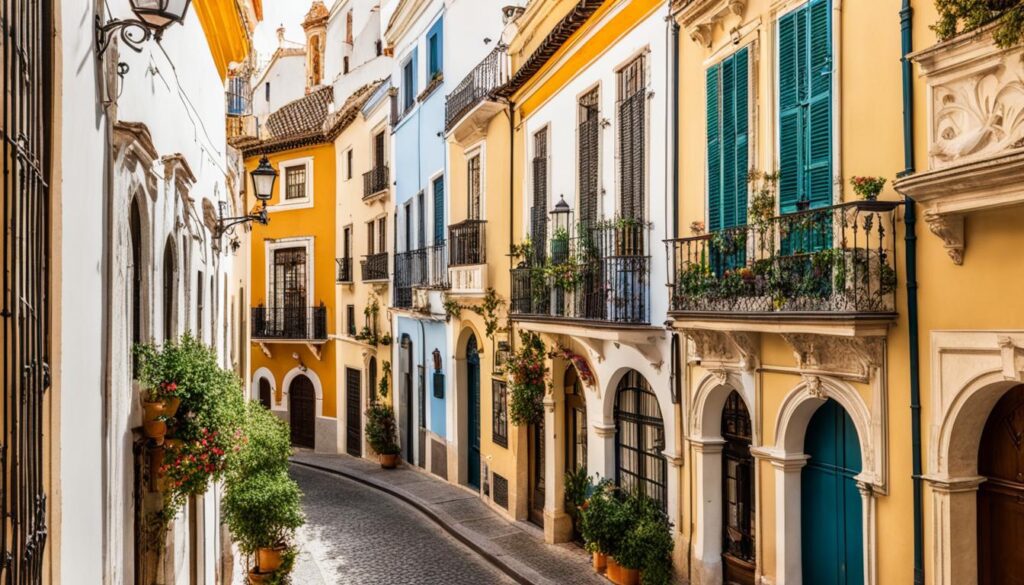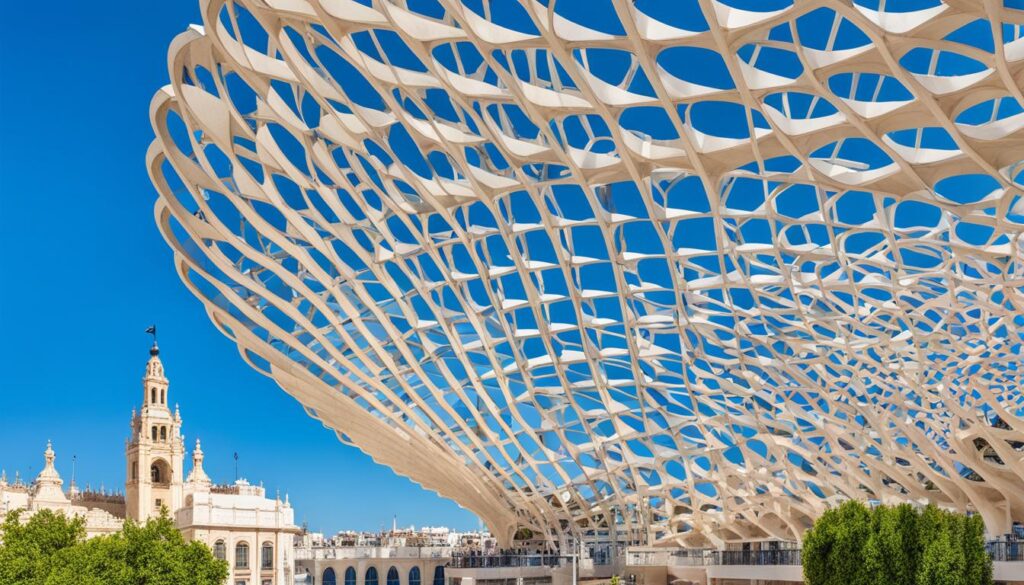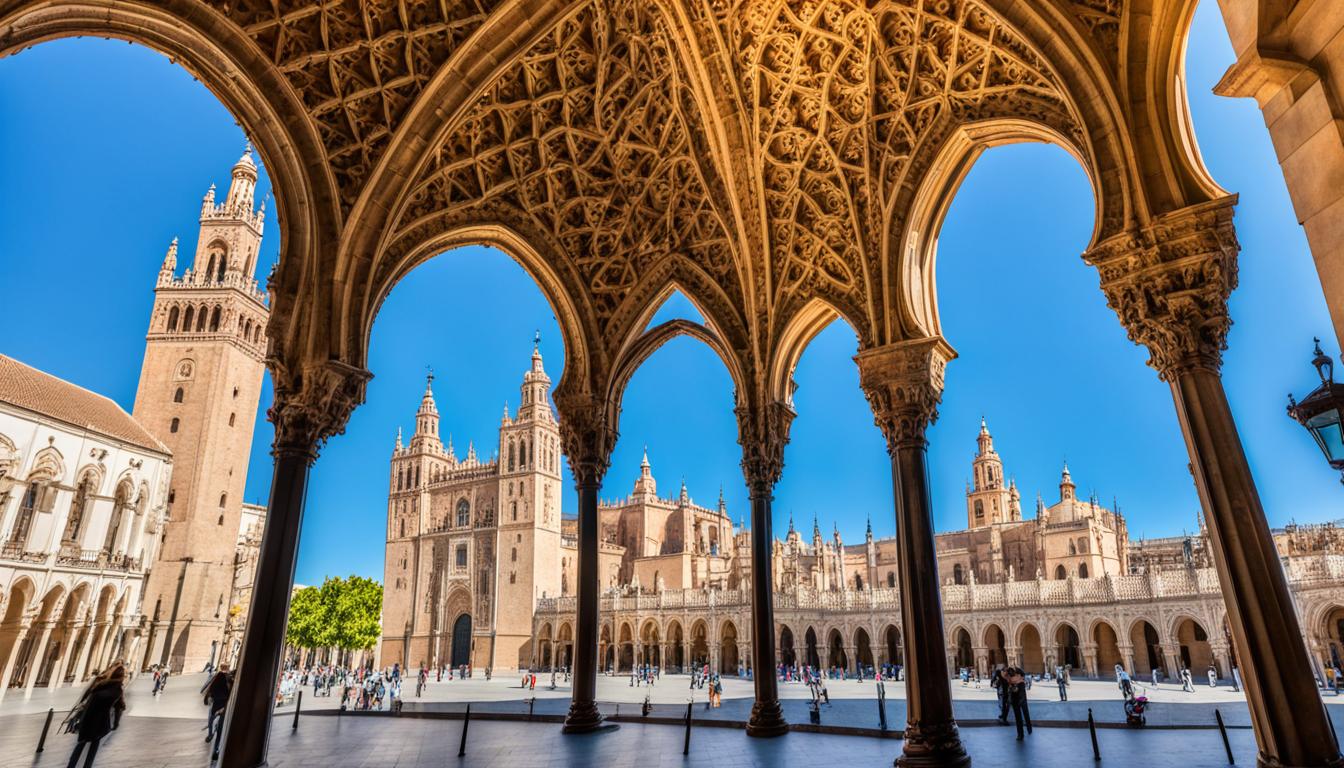Seville, the vibrant capital of Andalusia, is full of history and iconic landmarks. You’ll find everything from the stunning Moorish Royal Alcazar to the tall Gothic Seville Cathedral. This guide will take you through the best spots in Seville, giving you tips and info for a great visit.
Key Takeaways
- Seville is home to a wealth of must-see landmarks, including the Royal Alcazar, Seville Cathedral, Plaza de España, and more.
- The city’s landmarks showcase a mix of Moorish, Gothic, and Renaissance architectural styles, reflecting its rich cultural history.
- Visitors can explore the charming Santa Cruz district, stroll through the lush Maria Luisa Park, and immerse themselves in the vibrant Flamenco culture.
- Planning ahead and booking tickets in advance can help ensure a seamless and enjoyable experience when visiting Seville’s top attractions.
- Seville’s landmarks offer a glimpse into the city’s maritime history, aristocratic legacy, and Spain’s powerful past as a global empire.
Royal Alcazar: A Moorish Architectural Marvel
In the heart of Seville, the Royal Alcazar shows off the city’s Moorish past. This UNESCO site dates back to the 11th century. It’s a stunning mix of Islamic art and architecture.
The palace combines Moorish, Gothic, Mudéjar, and Renaissance styles. This creates a unique and captivating look.
Exploring the Ornate Halls and Tranquil Gardens
Walking into the Royal Alcazar, you feel like you’ve traveled back in time. The Patio de las Doncellas, or ‘Courtyard of the Maidens,’ is a highlight. It’s filled with beautiful Mudéjar details.
The gardens of the Alcazar are peaceful and full of life. You’ll find fountains, pools, and perfectly kept hedges.
Booking Tips for a Seamless Visit
Buying Royal Alcazar tickets ahead of time is a good idea. This limits the number of visitors per hour. It helps avoid long lines and makes your visit better.
Mornings are quieter, making them perfect for a peaceful visit. This way, you can enjoy the Moorish palace without the crowds.
The Royal Alcazar in Seville is a top spot for exploring the city’s culture. It has beautiful halls, peaceful gardens, and is close to the famous Seville Cathedral. This Moorish palace is an experience you won’t forget.
Seville Cathedral: A Towering Gothic Masterpiece
Seville Cathedral, also known as the Catedral de Santa María de la, stands tall over the city. It’s the biggest Gothic cathedral in the world. It took over a century to build, from 1401 to 1506. The cathedral is huge, covering 11,520 square meters, and its main nave reaches up to 42 meters high.
Marveling at the Largest Gothic Cathedral in the World
When you visit Seville Cathedral, you’ll be amazed by its size and beauty. It has 80 side chapels and a famous Gothic retablo in the main chapel. You can also see the tomb of Christopher Columbus, adding to its historical feel. Tickets are affordable, with discounts for students, seniors, and locals.
Climbing the Iconic Giralda Tower
Don’t miss climbing the Giralda Tower when you’re at Seville Cathedral. This tower was once part of a Moorish mosque. Built from 1184 to 1198, it has 35 ramps to the top, offering stunning views of the city. The tower’s bronze weather vane, El Giraldillo, is a symbol of Seville’s culture.
“The Seville Cathedral is a true architectural marvel, blending Gothic grandeur with Moorish influences to create a truly breathtaking landmark.” – [Name], Travel Enthusiast
Plaza de España: A Stunning Renaissance Revival Semicircle
In the heart of Seville lies the Plaza de España, a masterpiece of architecture. It features a Renaissance Revival-style semicircle design. Built for the Ibero-American Exposition of 1929, it combines Moorish and Spanish styles beautifully.
Admiring the Exquisite Tiled Alcoves
Visitors are captivated by the tiled alcoves around the semicircle. There are 48 alcoves, each showing a Spanish province. They are covered in vibrant ceramic tiles, telling the story of Spain’s history and regions.
The plaza also has beautiful bridges and fountains. These add to the picturesque setting, perfect for walks, photos, and enjoying Seville’s vibe. The plaza’s design and details make it a top spot in the city.
“The Plaza de España is a true architectural gem, a testament to the rich cultural heritage of Spain. Its blend of Renaissance and Moorish influences creates a truly captivating and unforgettable experience for all who visit.”
At the Plaza de España, you can enjoy the tiled alcoves, walk by the canals, or just soak up the atmosphere. It’s a key spot in Seville, celebrating Spain’s history and culture. It’s a landmark that will stay with you.
Barrio Santa Cruz: Seville’s Charming Old Jewish Quarter
In the heart of Seville lies the Barrio Santa Cruz, a captivating old Jewish quarter. It’s filled with winding streets, quaint plazas, and historic buildings. This area was once home to Spain’s second-largest Jewish community, showing off the city’s rich culture.
Close to the famous Alcazar and Cathedral, the Barrio Santa Cruz is a key spot in Seville. Visitors can explore charming restaurants, shops, and hidden courtyards. It’s a place where history and modern life blend beautifully.
Don’t miss the Iglesia de Santa María la Blanca, a former synagogue turned Baroque church. Also, the Casa de Pilatos, a stunning 15th-16th century palace, is a must-see. And, the General Archive of the Indies, a UNESCO site, is here too. It’s filled with documents from Spain’s colonial past.
The Barrio Santa Cruz is a mix of history, culture, and modern charm. It’s a top spot for anyone visiting the old town of Seville and the seville jewish quarter.
| Landmark | Description |
|---|---|
| Iglesia de Santa María la Blanca | A former synagogue turned Baroque church, featuring Murillo’s paintings. |
| Casa de Pilatos | A 15th-16th century palace with Mudéjar, Gothic, and Renaissance styles. |
| General Archive of the Indies | A UNESCO site with over 80 million historical documents on Spain’s colonial empire. |

“The Barrio Santa Cruz offers an incomparable feeling of fullness and boasts historical sites like the Venerable Hospital, constructed in 1675.”
Maria Luisa Park: A Verdant Oasis in the Heart of Seville
In the heart of Seville lies the Maria Luisa Park, a green oasis. It was once part of the Palace of San Telmo’s gardens. In 1893, Infanta Maria Luisa Fernanda de Borbón gave it to the city. Now, it’s a favorite spot for everyone.
The maria luisa park seville covers 84 acres. It has peaceful ponds, colorful flower beds, and beautiful plazas. You can walk through the park and enjoy the parque de maría luisa and seville gardens.
Strolling Through the Lush Gardens and Iconic Monuments
The Plaza de España is a highlight of the park. It’s a grand spot that shows the park’s history and culture. You can see tiled alcoves, a big semicircular building, and enjoy the calm.
The park has more to see, like the Archaeological Museum and the Museum of Popular Arts and Customs of Seville. There are also roundabouts for famous people like Bécquer and Dante Alighieri.
For families, there’s a duck lake and pigeons in the Plaza de América. The park is perfect for a peaceful walk, cultural exploration, or a fun day with kids. The Maria Luisa Park is a top spot in Seville.
Metropol Parasol: Seville’s Contemporary Architectural Gem
The Metropol Parasol, or “Mushrooms of Seville,” stands tall in the city’s historic heart. It’s a modern landmark that draws in visitors. Finished in 2011, it has winding paths and a spot for amazing views of Seville.
Exploring the Winding Walkways and Panoramic Views
Start a journey through the Metropol Parasol’s unique design. It mixes modern and traditional styles. The structure has five levels, like an archaeological museum, a food market, a square, and a spot for great views.
The panoramic viewing point offers a 250-meter-long catwalk. Here, you can see the Guadalquivir River and historic sites. You’ll see the Seville Cathedral and the Royal Alcazar from up high.
| Key Facts about the Metropol Parasol | Details |
|---|---|
| Construction Period | 2006 – 2011 |
| Dimensions | 150 meters long by 70 meters wide |
| Construction Materials | 3,500 pieces of wood, 16 million screws |
| Levels | 5 (including museum, market, square, and viewing point) |
| Panoramic Viewing Point | 250-meter-long catwalk |
The Metropol Parasol, or “Mushrooms of Seville,” is a top spot in the city. It’s perfect for those who love modern architecture. You can enjoy the design, the views, or the lively food market. It’s an experience you won’t forget.

sevilla must-see landmarks: Uncovering Seville’s Rich Heritage
Seville’s landmarks let visitors peek into the city’s deep cultural history and past. You can see the Moorish beauty of the Royal Alcazar and the Gothic grandeur of the Seville Cathedral. These sites show how different styles of architecture have changed the city over time.
Exploring Seville’s history is easy in the charming Barrio Santa Cruz. You can also see the Renaissance Plaza de España and learn about the city’s sea history at the Torre del Oro. These seville landmarks help visitors understand and value Seville’s lively spirit and lasting seville cultural attractions.
The Real Fábrica de Tabacos shows Seville’s industrial past. The Metropol Parasol, a modern wonder, offers amazing views of the city. These seville historic sites and attractions highlight the city’s rich seville heritage and variety.
“Seville is the spiritual home of flamenco, and experiencing the passionate performances at the city’s tablaos is a must for any visitor.”
By visiting Seville’s landmarks, you can learn about its history, see amazing architecture, and dive into the lively seville cultural attractions. This makes Seville a captivating place to visit.
| Seville Landmark | Highlights | Entrance Fee |
|---|---|---|
| Royal Alcazar | Moorish architectural marvel, ornate halls, tranquil gardens | €13.50 (€9 for EU citizens) |
| Seville Cathedral | Largest Gothic cathedral in the world, Giralda tower | €10 (€5 for EU citizens) |
| Plaza de España | Stunning Renaissance revival semicircle, exquisite tiled alcoves | Free to visit |
| Barrio Santa Cruz | Charming old Jewish quarter | Free to explore |
| Torre del Oro | Historic maritime tower on the Guadalquivir River | €3 (€1.50 for EU citizens) |
Flamenco Shows: Experiencing the Passion of Andalusian Culture
No visit to Seville is complete without diving into flamenco, a key part of Andalusian culture. Seville is the heart of this Spanish art form. It offers many ways to see the best flamenco shows and performances in the city.
Discovering the Best Tablaos and Performances
The Triana district is famous for its flamenco scene. It’s by the Guadalquivir River and is full of tablaos and big stage shows. Each place gives a special look into flamenco’s deep emotions and expressions.
- T de Triana (Esencia): Known for its real and close-up atmosphere, this tablao is a top spot for experiencing Andalusian culture in Seville.
- Peña Torres Macarena: With a weekly flamenco show every Wednesday at 9:30 pm, this venue offers an evening full of Seville flamenco passion.
- Casa de La Memoria: Showing daily shows at 7:30 pm and 9 pm, this tablao is famous for its top-notch Seville flamenco shows.
- Los Gallos: With performances twice a day at 8:30 pm and 10:30 pm, this place is a must-see for flamenco fans.
- El Arenal: Showing shows at 7:30 pm and 9:30 pm, this tablao is known for its great Seville flamenco experience.
- La Carbonería: Offering a unique flamenco experience with shows at 7 pm and during peak season at 8:45 pm, this venue is a hidden gem in Seville’s flamenco scene.
- Museo del Baile Flamenco: Combining a museum visit with a live flamenco performance, this immersive experience lets visitors explore the art form’s rich history and tradition.
From small tablao shows to big stage productions, these shows give a deep look into the music, song, and dance of flamenco. They show the emotional and expressive side of this Spanish art form.
| Venue | Address | Show Times | Entrance Fee |
|---|---|---|---|
| T de Triana (Esencia) | Calle Pureza, 67, 41010 Seville | Free entry | Free entry |
| Peña Torres Macarena | Calle Virgen de la Alegria, 18, 41010 Seville | Wednesdays at 9:30 pm | €6 |
| Casa de La Memoria | Calle Cuna, 6, 41004 Seville | Daily at 7:30 pm and 9 pm | €18 |
| Los Gallos | Calle Ximenez de Enciso, 28, 41004 Seville | Daily at 8:30 pm and 10:30 pm | €35 |
| El Arenal | Calle Arfe, 19, 41001 Seville | Daily at 7:30 pm and 9:30 pm | €39 |
| La Carbonería | Calle Levies, 18, 41001 Seville | Daily at 7 pm, and during peak season at 8:45 pm | €20 |
| Museo del Baile Flamenco | Calle Manuel Rojas Marcos, 3, 41004 Seville | Museum visit and flamenco performance | €10 museum visit, €24 combination ticket |
Whether you want an intimate, real flamenco experience or a big, theatrical show, Seville’s flamenco scene is perfect. It lets you dive deep into the passion and art of this Andalusian culture.
Torre del Oro: A Glimpse into Seville’s Maritime Legacy
The Torre del Oro, or “Tower of Gold,” stands tall by the Guadalquivir River in Seville. It’s a symbol of the city’s rich maritime history. Built in the 13th century, it was key to controlling the port of Seville. Over the years, it has seen many attacks and sieges, proving the city’s strength.
In 1760, a cupola was added to the top, making it even more striking. Today, the Torre del Oro is a naval museum. It tells the story of Seville’s seafaring past and its link to the Guadalquivir River. Visitors can learn about the river’s importance and the journeys of famous sailors from Seville.
At the Torre del Oro, you can dive into its history and see amazing artifacts. From its role in controlling the river to becoming a museum, it’s a beloved landmark. It shows Seville’s deep maritime roots.
| Fact | Detail |
|---|---|
| Construction | The Torre del Oro was built in 1220 during the Almohad period. |
| Purpose | The tower was used to control access to the Guadalquivir River and Seville’s port. |
| Architectural Features | The tower’s distinctive cupola-shaped top was added in 1760. |
| Historical Use | The tower served as a chapel, a prison, and part of Seville’s defensive wall over the centuries. |
| Current Status | The Torre del Oro now houses a naval museum showcasing Seville’s maritime history. |
The Torre del Oro in Seville is a must-see monument. It shows the city’s deep maritime history. From its strategic role to its museum status, it continues to amaze visitors. It reminds us of Seville’s lasting bond with the Guadalquivir River and the sea.
Real Fábrica de Tabacos: Seville’s Historic Tobacco Factory
In the heart of Seville, the Real Fábrica de Tabacos is a symbol of the city’s industrial past. This grand neo-classical building was once the center of Europe’s tobacco production. It played a key role in making and sharing cigarettes across the continent.
It was built in the 18th century. Back then, it was Spain’s second-largest building, measuring 185 meters by 147 meters. At its busiest, the factory had 6,000 workers, mostly women. They made about 75% of Europe’s cigarettes.
Now, the old seville tobacco factory is home to the University of Seville’s main offices and faculties. This lets visitors see its history and stunning architecture. Its design, with inverted arches to prevent flooding, makes it culturally important. It’s seen as a key seville historic building.
Visitors can explore 14 courtyards, rooms, and galleries. These spaces offer a peek into the lives of the workers who were there. The old jail, where smugglers were kept, is a reminder of the factory’s history.
Walking through the real fábrica de tabacos seville, you’re amazed by its size and beauty. It was crucial for Seville’s growth and economy. Now, it shows the city’s ability to keep its history alive for the future.
“The Real Fábrica de Tabacos is not just a building, but a window into Seville’s rich history and the ingenuity of its people.”
Conclusion: Embracing the Vibrant Spirit of Seville
Seville’s landmarks and attractions offer a mix of culture, history, and architecture. They show the city’s lively spirit. From the Royal Alcazar‘s Moorish beauty to the Metropol Parasol‘s modern design, each spot has its own story. These stories add to Seville’s fame as a top seville travel guide spot in Spain.
Visitors can connect with Seville’s history and enjoy its lively present at these sites. This makes their trip memorable in one of Europe’s most exciting seville tourism spots.
Seville has many attractions, like the Cathedral of Seville, the Barrio Santa Cruz, and Maria Luisa Park. Each place offers something special for everyone. By diving into the city’s culture, history, and beauty, you’ll discover what makes Seville enchanting.
Planning your visiting seville spain trip? Let Seville’s landmarks and experiences draw you in. Embrace the city’s energy and get lost in its cultural richness. Get ready to be amazed by Seville’s beauty, history, and passion.

